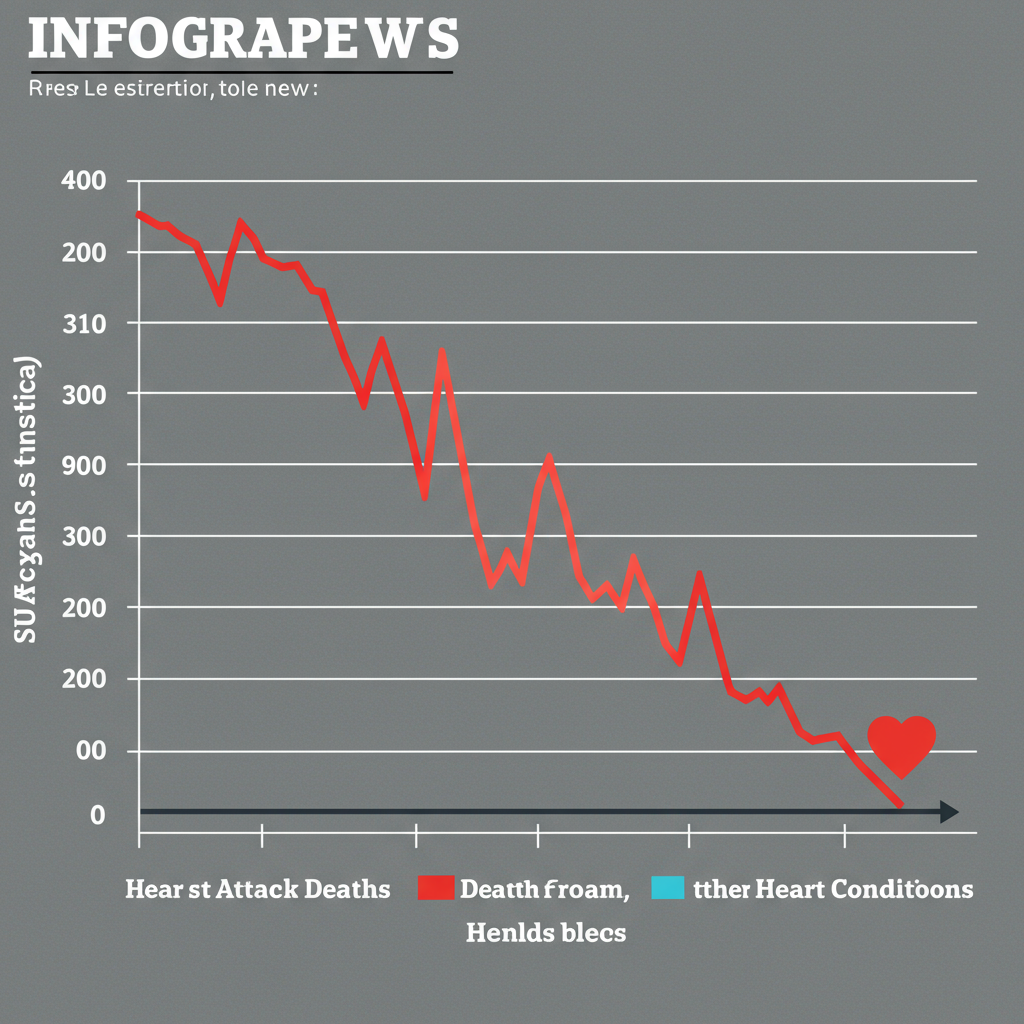Startling new data reveals a significant shift in what’s causing deaths among Americans diagnosed with heart disease. While heart disease tragically remains the leading overall cause of death in the U.S., the primary culprit within that category is no longer heart attacks. This major change, highlighted in a recent report, underscores the evolving nature of cardiovascular health risks and points to other conditions that now pose a greater threat. Understanding this shift is crucial for anyone seeking to protect their heart health.
The Changing Landscape of Heart Disease Deaths
For decades, acute myocardial infarction, commonly known as a heart attack, was the most frequent cause of death within the broad category of heart disease. However, a comprehensive new report published in the Journal of the American Heart Association indicates a dramatic reversal of this trend over the past 50 years.
The report analyzed mortality data and found that deaths specifically attributed to heart attacks have plummeted by an astonishing 89% between 1970 and 2022. In 1970, ischemic heart disease, which includes heart attacks, accounted for a staggering 91% of all heart disease-related fatalities. By 2022, that figure had fallen to just 53%. While this is positive news regarding heart attack survival, the overall picture of heart disease mortality is more complex. Total deaths from heart disease have decreased by a notable 66% since 1970, but the condition stubbornly holds its position as the top killer in the United States.
What Conditions Are Rising Instead?
As heart attack deaths have become less common, fatalities from other forms of heart disease have unfortunately seen a sharp increase. These conditions collectively now represent a significant 81% of all heart-related deaths. The report points to substantial rises in mortality rates for specific conditions:
Heart failure deaths have climbed by 81%.
Deaths linked to hypertension-related heart disease have surged by 106%.
Fatalities associated with arrhythmias, or abnormal heart rhythms, have seen the most alarming increase, skyrocketing by 450%.
This data paints a clear picture: while surviving a heart attack is more likely today, other cardiovascular conditions are becoming increasingly deadly, fundamentally altering the profile of heart disease mortality in the U.S.
Why Heart Attack Deaths Are Declining
Experts emphasize that the significant drop in heart attack fatalities does not necessarily mean fewer heart attacks are occurring. Instead, it primarily reflects a remarkable improvement in the ability to survive them. As cardiologist Dr. Jayne Morgan noted, heart attacks are simply “more and more survivable now as compared to 55 years ago.”
This enhanced survivability is a direct result of groundbreaking advancements in medical care over the past half-century. Improvements in emergency medical services mean patients receive critical care faster. Contemporary medications are more effective at treating heart attacks and preventing complications. Lifesaving procedures like angioplasty and stenting, as well as medical devices such as defibrillators, play a crucial role in interrupting heart attacks and stabilizing patients. These medical triumphs allow more individuals to survive the initial event, changing the trajectory of heart disease outcomes.
The Lingering Impact: Chronic Conditions and Aging
While surviving a heart attack is a victory, it often leaves lasting effects on the heart. The damage to heart muscle tissue caused by a non-fatal heart attack can lead to chronic conditions over time. Dr. Cheng-Han Chen, another expert, explained that heart muscle damage is a major contributor to the development of conditions like heart failure. Heart failure, which describes the heart’s diminished ability to pump blood effectively, can range from mild to severe and significantly impacts long-term health and mortality risk, even if manageable with medication.
Therefore, as more people survive heart attacks, a larger population lives longer with hearts that may be compromised, making them more susceptible to developing heart failure and other issues later in life. Furthermore, simply living longer naturally increases the risk of age-associated cardiovascular conditions, including heart failure, hypertension-related heart disease, and various types of arrhythmias.
Beyond Survival: Lifestyle Factors Drive Rising Deaths
While improved heart attack survival and increased longevity contribute to the rise of other heart conditions, lifestyle factors play a critical and increasing role in the high risk for these specific diseases. The typical American lifestyle, marked by several interconnected factors, significantly fuels the prevalence of heart failure, hypertension, and arrhythmias.
Major contributors include:
Obesity: Particularly the accumulation of body fat, which studies now suggest is a stronger predictor of mortality risk, especially from heart disease, than BMI alone. Research analyzing data from the National Health and Nutrition Examination Survey (NHANES) linked high body fat percentage to a 262% higher chance of dying from heart disease compared to those without high body fat, a risk BMI didn’t detect.
Sedentary Habits: Lack of physical activity weakens the heart and contributes to other risk factors.
Poor Diet: Diets high in processed foods, fast food, added sugars, and saturated fats contribute to weight gain, high cholesterol, high blood pressure, and inflammation.
Smoking and Tobacco Use: A well-established, major risk factor for all forms of cardiovascular disease.
High Cholesterol, High Blood Pressure, and Diabetes: These metabolic conditions, often linked to lifestyle, significantly increase strain on the heart and blood vessels.
Societal Stressors: Chronic stress can lead to inflammation and unhealthy coping mechanisms, negatively impacting heart health.
Other important factors mentioned include socioeconomic issues and pregnancy complications like hypertension of pregnancy, preeclampsia, and gestational diabetes. These latter factors are increasingly recognized for significantly impacting women’s lifetime risk of heart disease and contributing to concerning rates of maternal mortality.
The sharpest rise in deaths was seen in arrhythmia-related fatalities. While many arrhythmias are harmless, severe abnormal heart rhythms can disrupt blood flow, potentially damaging vital organs and leading to death.
Another lifestyle consideration gaining attention is cannabis use. A recent analysis in the journal Heart, synthesizing data from studies involving nearly 200 million people, found a significant link between frequent cannabis use and increased cardiovascular risks. Frequent users had double the risk of dying from cardiovascular disease, a 29% higher risk of acute coronary syndrome, and a 20% higher risk of stroke. Experts like Dr. Robert Page II consider smoking cannabis potentially as harmful a risk factor as smoking cigarettes for premature atherosclerotic cardiovascular disease. While debate exists regarding the extent of risk across different forms of consumption, the data signals a need for caution, particularly for individuals with pre-existing heart conditions.
Conversely, some lifestyle choices show potential benefit. An observational study published in The Journal of Nutrition suggests that daily consumption of one to three cups of caffeinated black coffee, without significant added sugar or saturated fats, may be associated with a 14% lower overall mortality risk and a reduced risk of death specifically from cardiovascular disease. The key takeaway is that additions can negate potential benefits, reinforcing the importance of mindful consumption.
Taking Action: Protecting Your Heart
Given the rising threat from heart failure, hypertension-related disease, and arrhythmias, proactive steps to protect cardiovascular health are more critical than ever. Adopting healthy habits can significantly lower your risk.
Proven Habits from a Cardiologist
Dr. Haider, an interventional cardiologist known online as @yourheartdoc, shares practical, consistent habits he follows to maintain his heart health, emphasizing balance and realism over perfection:
Prioritize What Matters: Intentionally schedule time for health, family, and purpose. View healthy habits as non-negotiable appointments.
Be Consistent, Not Perfect: Aim for sustainable efforts in exercise, sleep, and diet. Allow occasional indulgences without guilt, as consistency builds a buffer.
Focus on Balanced Nutrition: Follow a flexible approach like a Mediterranean-themed diet focusing on vegetables, fruits, whole grains, and lean protein, while limiting processed items and added sugars. Manage overall calorie intake weekly rather than daily strictness. (Note: While intermittent fasting shows promise, conflicting recent research highlights the need for more study, so consult your doctor).
Enjoy Moving Your Body: Find activities you like and do what’s possible, even with limitations. Aim for at least 7,000 steps daily, with over 10,000 being better for mortality risk reduction according to some studies. Consistency, even 30 minutes a week, benefits health, especially for inactive individuals.
Manage Stress: Set clear boundaries between work and personal life. Create transition rituals and practice saying no to protect your time and mental space.
Take Sleep Seriously: Aim for an average of 7–9 hours of quality sleep per night. Poor sleep hygiene is directly linked to negative cardiac outcomes.
Build Small, Consistent Habits: Focus on simple tracking like steps via smartphone or getting regular check-ups to monitor blood pressure, cholesterol, and weight. Avoid relying on supplements unless specifically advised by a doctor, as they lack proven benefits for heart health.
Be Proactive: Regularly assess your routines and adjust as needs change with age or life circumstances. Learn from observing health trends and make manageable changes now rather than waiting for problems.
The AHA “Essential Eight” Framework
The American Heart Association provides a clear framework for optimal heart health called the “Essential Eight.” Focusing on these areas offers a comprehensive approach to reducing your risk of heart failure, hypertension, arrhythmias, and other cardiovascular issues:
- Eat Healthy: Prioritize nutrient-dense foods.
- Be More Active: Get regular physical exercise.
- Quit Tobacco: Avoid smoking and other tobacco products entirely.
- Get Healthy Sleep: Aim for sufficient, quality sleep.
- Manage Weight: Maintain a healthy body weight, focusing on body composition.
- Control Cholesterol: Keep cholesterol levels within a healthy range.
- Regulate Blood Sugar: Manage blood sugar levels, especially if you have diabetes.
- Manage Blood Pressure: Keep blood pressure levels controlled.
Adhering to these principles and incorporating healthy lifestyle choices addresses the root causes contributing to the rise of heart failure, hypertension, and arrhythmias.
Regular Check-ups and Recognizing Symptoms
Regular visits to your doctor are essential for monitoring your cardiovascular risk factors like blood pressure, cholesterol, and blood sugar. Early detection and management of conditions like hypertension are key to preventing future complications.
Furthermore, pay attention to your body. If you experience noticeable heart palpitations (a feeling of a racing, pounding, or fluttering heart), it’s important to consult a doctor to rule out potentially serious arrhythmias. For individuals who have survived a heart attack, actively working with your medical team to reduce the risk of post-MI arrhythmias through appropriate medications and lifestyle changes is crucial.
Frequently Asked Questions
What specific heart conditions are now causing more deaths than heart attacks in the US?
According to recent data from the Journal of the American Heart Association, while heart attack deaths have significantly decreased, fatalities from other cardiovascular conditions have risen. The report specifically highlights notable increases in deaths from heart failure, hypertension-related heart disease, and especially arrhythmias (abnormal heart rhythms). These conditions collectively represent a growing proportion of heart disease mortality.
Where can I find reliable guidance and resources for improving my heart health habits?
Reliable guidance for heart health can be found through reputable organizations like the American Heart Association (AHA), which offers frameworks such as the “Essential Eight.” Consulting with a qualified healthcare professional, such as a primary care doctor or cardiologist, is also crucial. They can provide personalized advice, conduct necessary screenings (like checking blood pressure, cholesterol, and blood sugar), and help you develop a safe and effective plan based on your individual health profile. Resources like Healthline.com also provide evidence-based health information.
Should I be concerned about specific lifestyle factors like diet, exercise, or cannabis use in light of these rising heart risks?
Yes, lifestyle factors are major contributors to the rising rates of heart failure, hypertension, and arrhythmias. Unhealthy habits like poor diet, lack of exercise, smoking, chronic stress, and insufficient sleep significantly increase risk. Additionally, recent studies indicate frequent cannabis use is linked to increased risks of cardiovascular death, stroke, and arrhythmias. Adopting healthy lifestyle patterns, such as following a balanced diet, engaging in regular physical activity, avoiding smoking, managing stress, and getting enough sleep, is essential for mitigating these risks and protecting your heart. Discuss any lifestyle concerns, including cannabis use, with your doctor.
Conclusion
The data is clear: the leading causes of death within heart disease have shifted. While fewer Americans may be dying from* heart attacks directly, the rise in fatalities from heart failure, hypertension, and arrhythmias presents a new challenge. This shift underscores the critical importance of focusing on overall cardiovascular health beyond just preventing a single event. By understanding the new landscape of heart risks – driven by improved survival, aging, and crucially, prevalent lifestyle factors – individuals can take proactive steps. Embracing proven habits, following expert advice, and utilizing frameworks like the AHA’s Essential Eight empowers you to significantly reduce your risk and protect your heart against these evolving threats. Regular check-ups and open communication with your doctor are your best defense in navigating this changing heart health environment.




